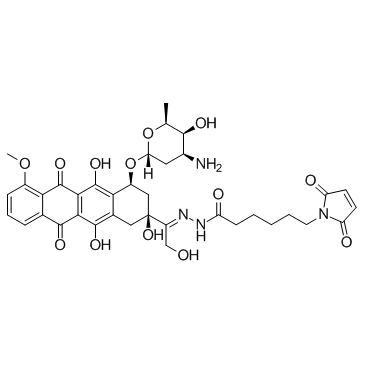| Description |
Aldoxorubicin (INNO-206) is an albumin-binding prodrug of doxorubicin, which is released from albumin under acidic conditions. Aldoxorubicin (INNO-206) has potent antitumor activities in various cancer cell lines and in in murine tumor models.
|
| Related Catalog |
|
| Target |
Topoisomerase II
|
| In Vitro |
Aldoxorubicin (INNO-206) (0.27 to 2.16 μM) inhibits blood vessel formation and reduces multiple myeloma cell growth in a pH-dependent fashion[1].
|
| In Vivo |
Aldoxorubicin (INNO-206) (10.8 mg/kg, i.v.) shows significantly smaller tumor volumes and IgG levels on days 28, and is well tolerated with 90% of mice surviving until the termination of the study in the mice bearing the LAGκ-1A tumor[1]. Aldoxorubicin (INNO-206) shows a good safety profile at doses up to 260 mg/mL doxorubicin equivalents, and is able to induce tumor regressions in breast cancer, small cell lung cancer and sarcoma in phase I study[2]. Aldoxorubicin (INNO-206) shows superior activity over doxorubicin in a murine renal cell carcinoma model and in breast carcinoma xenograft models[3].
|
| Cell Assay |
Cells are seeded at 1×105 cells/100 μL/well in 96-well plates in RPMI-1640 media with FBS for 24 hours before treatment. Cells are cultured in the presence of medium, Aldoxorubicin (INNO-206) or doxorubicin for 48 hours. Next, cell viability is quantified using the CellTiter 96 AQueous Non-Radioactive Cell Proliferation Assay. Each well is treated with MTS for 1 to 4 hours, after which absorbance at 490 nm is recorded using a 96-well plate reader. The quantity of formazan product as measured is directly proportional to the number of living cells. Data graphed are means±SEM using 3 replicates per data point.
|
| Animal Admin |
For the LAGκ-1A experiment, Aldoxorubicin (INNO-206) is administered to SCID mice at 10.8 mg/kg (doxorubicin equivalent dose of 8.0 mg/kg) once weekly. Mice are treated with conventional doxorubicin at 4.0 and 8.0 mg/kg once weekly. For the LAGκ-2 experiment, Aldoxorubicin (INNO-206) is administered once weekly (W) at doses of 2.7 and 5.4 mg/kg, or on 3 consecutive days (W-F) weekly at doses of 0.9 and 1.8 mg/kg. Bortezomib is administered twice weekly (W, F) at a dose of 0.5 mg/kg. Doxorubicin is administered to SCID mice at 2, 4, and 8 mg/kg, and PLD is administered to SCID mice at 2 mg/kg once weekly. Each drug is administered i.v. in a volume of 100 μL.
|
| References |
[1]. Eric Sanchez, et al. Anti-Myeloma Effects of the Novel Anthracycline Derivative INNO-206. Clin Cancer Res.2012 18; 3856. [2]. Kratz, F. INNO-206 (DOXO-EMCH), an Albumin-Binding Prodrug of Doxorubicin Under Development for Phase II Studies. Current Bioactive Compounds, 2011, 7(1): 33-38(6) [3]. Graeser R, et al. INNO-206, the (6-maleimidocaproyl hydrazone derivative of doxorubicin), shows superior antitumor efficacy compared to doxorubicin in different tumor xenograft models and in an orthotopic pancreas carcinoma model. Invest New Drugs. 2010 F [4]. Walker L, et al. Cell penetrating peptides fused to a thermally targeted biopolymer drug carrier improve the delivery and antitumor efficacy of an acid-sensitive doxorubicin derivative. Int J Pharm. 2012 Oct 15;436(1-2):825-32.
|
